Learn about the history and significance of National Look Alike Day, fun activities to celebrate the day, and interesting facts about doppelgangers and look-alikes. Discover why people love this holiday and how it promotes inclusivity, self-expression, and curiosity.
National Look Alike Day is an unofficial holiday celebrated on April 20th each year. It is a day to recognize and celebrate people who look alike, whether they are identical twins, doppelgangers, or just people who happen to bear a strong resemblance to each other. This day is also an opportunity for people to dress up as their favorite celebrity or fictional character who they resemble, or to find their look-alike and take a picture together. The purpose of National Look Alike Day is to celebrate the uniqueness and diversity of individuals while also acknowledging the fun and curiosity that comes with discovering people who look like each other.
History of National Look Alike Day
The history of National Look Alike Day is unclear, as it is not an official holiday recognized by any government or organization. It is likely that the holiday originated as a fun way to celebrate the idea of look-alikes and the fascination that people have with finding their doubles.
The earliest known reference to National Look Alike Day is in a 2006 article by USA Today, which mentioned the holiday as one of the many unusual celebrations that occur throughout the year. Since then, the holiday has gained popularity through social media and word of mouth, with people around the world using the day to dress up as their favorite celebrity or to share pictures of themselves with their doppelgangers.
Overall, National Look Alike Day is a lighthearted and fun holiday that celebrates the idea of finding similarities between people, whether they are related or not. While its origins may be unclear, its popularity continues to grow as more and more people embrace the idea of celebrating their unique and shared traits with others.

Source: pixabay.com
National Look Alike Day Activities
National Look Alike Day is a day to celebrate and have fun with the idea of look-alikes. Here are some activities you can do to celebrate the day:
- Dress up as your favorite celebrity or fictional character who you resemble. Take a picture and share it on social media using the hashtag #NationalLookAlikeDay.
- Find your doppelganger. Use facial recognition software, social media platforms or ask friends and family members who they think you resemble. Take a picture together and share it on social media.
- Watch movies or TV shows featuring look-alikes such as “The Parent Trap,” “The Double,” or “Multiplicity.”
- Have a themed party where everyone dresses up as their look-alike. You can even have a contest for the best look-alike costume.
- Create a collage or art project featuring look-alikes. Use magazines, newspapers, and other materials to create a piece that celebrates the uniqueness of different people who resemble each other.
Remember, National Look Alike Day is all about having fun and celebrating the similarities between people. So get creative and have fun with it!
Interesting Fun Facts About Look Alike
Here are some interesting and fun facts about look-alikes:
- There is a scientific term for look-alikes called “doppelgangers.” The term comes from the German word “doppel” which means double and “ganger” which means walker or goer.
- Some celebrities have famous doppelgangers. For example, actor Jeffrey Dean Morgan has a doppelganger named Javier Bardem, and actress Isla Fisher has a doppelganger named Amy Adams.
- Identical twins are not the only people who can look alike. Non-twin siblings, cousins, and even unrelated people can bear a striking resemblance to each other.
- People tend to be attracted to others who resemble themselves or someone they admire. This phenomenon is known as “implicit egotism.”
- Studies have shown that people tend to trust and like others who resemble themselves. This is known as the “similarity-attraction effect.”
- The likelihood of finding your doppelganger is relatively high, as there are only a limited number of facial features and combinations that humans can have.
- There are several websites and apps that use facial recognition software to help people find their doppelgangers, such as Twin Strangers and Looky-Looky.
- In some cultures, doppelgangers are believed to be an omen of bad luck or even death.
- The earliest known reference to the concept of a doppelganger dates back to ancient Egyptian mythology, where the god Bes was said to have a doppelganger named Aha.
- Some people have made a career out of being a professional doppelganger or impersonator, such as Elvis Presley impersonators or Prince William look-alikes.
Why We Love and Celebrate National Look Alike Day
There are several reasons why people love and celebrate National Look Alike Day:
- It’s fun: National Look Alike Day is a lighthearted and fun holiday that encourages people to have fun and celebrate the similarities between people.
- It’s inclusive: National Look Alike Day is a celebration of diversity and inclusivity, as people of all ages, races, and backgrounds can participate in the holiday.
- It sparks curiosity: The idea of finding one’s doppelganger or resemblance to a celebrity or fictional character can spark curiosity and excitement in people.
- It’s relatable: Many people have experienced the feeling of being told that they resemble someone else, whether it’s a family member or a celebrity. National Look Alike Day provides an opportunity to celebrate and embrace these similarities.
- It promotes self-expression: National Look Alike Day encourages people to express themselves through creative costumes, art projects, and social media posts.
Overall, National Look Alike Day is a holiday that celebrates the uniqueness and similarities between people in a fun and lighthearted way. It encourages people to embrace their own individuality and to appreciate the diversity of others.